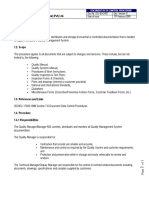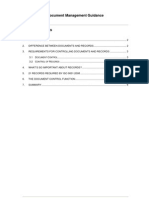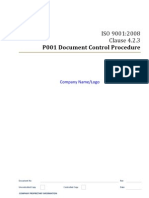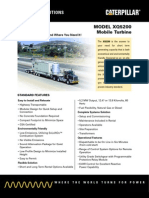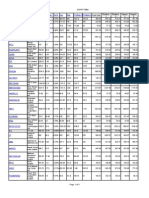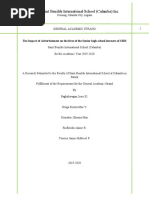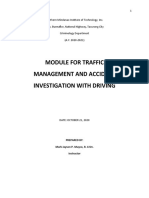0 ratings0% found this document useful (0 votes)
591 views16 - Construction Management Procedures 16.5 - Construction Document Control
16 - Construction Management Procedures 16.5 - Construction Document Control
Uploaded by
sam_antony2005This document outlines procedures for construction document control to ensure all project documents and correspondence are properly tracked and processed. It discusses establishing a central document control point where all project mail and deliveries are received and logged into a tracking system. For small projects, manual logs may suffice, while medium and large projects likely require computerized tracking systems. The document control clerk is responsible for seven key functions including receiving, logging, distributing, and filing all incoming and outgoing project documents and correspondence to facilitate efficient document management.
Copyright:
© All Rights Reserved
Available Formats
Download as PDF, TXT or read online from Scribd
16 - Construction Management Procedures 16.5 - Construction Document Control
16 - Construction Management Procedures 16.5 - Construction Document Control
Uploaded by
sam_antony20050 ratings0% found this document useful (0 votes)
591 views3 pagesThis document outlines procedures for construction document control to ensure all project documents and correspondence are properly tracked and processed. It discusses establishing a central document control point where all project mail and deliveries are received and logged into a tracking system. For small projects, manual logs may suffice, while medium and large projects likely require computerized tracking systems. The document control clerk is responsible for seven key functions including receiving, logging, distributing, and filing all incoming and outgoing project documents and correspondence to facilitate efficient document management.
Original Description:
idea about document control
Original Title
Document Control
Copyright
© © All Rights Reserved
Available Formats
PDF, TXT or read online from Scribd
Share this document
Did you find this document useful?
Is this content inappropriate?
This document outlines procedures for construction document control to ensure all project documents and correspondence are properly tracked and processed. It discusses establishing a central document control point where all project mail and deliveries are received and logged into a tracking system. For small projects, manual logs may suffice, while medium and large projects likely require computerized tracking systems. The document control clerk is responsible for seven key functions including receiving, logging, distributing, and filing all incoming and outgoing project documents and correspondence to facilitate efficient document management.
Copyright:
© All Rights Reserved
Available Formats
Download as PDF, TXT or read online from Scribd
Download as pdf or txt
0 ratings0% found this document useful (0 votes)
591 views3 pages16 - Construction Management Procedures 16.5 - Construction Document Control
16 - Construction Management Procedures 16.5 - Construction Document Control
Uploaded by
sam_antony2005This document outlines procedures for construction document control to ensure all project documents and correspondence are properly tracked and processed. It discusses establishing a central document control point where all project mail and deliveries are received and logged into a tracking system. For small projects, manual logs may suffice, while medium and large projects likely require computerized tracking systems. The document control clerk is responsible for seven key functions including receiving, logging, distributing, and filing all incoming and outgoing project documents and correspondence to facilitate efficient document management.
Copyright:
© All Rights Reserved
Available Formats
Download as PDF, TXT or read online from Scribd
Download as pdf or txt
You are on page 1of 3
Bureau of Engineering
Project Delivery Manual
Chapter: 16 CONSTRUCTION MANAGEMENT
PROCEDURES
Procedure: 16.5 CONSTRUCTION DOCUMENT CONTROL
Revised: March 18, 2009
PURPOSE
Document control establishes a central point where all project related
correspondence and documents are logged and tracked. The purpose of document
control is to ensure that all project required documents and/or correspondence is
processed as required and in a timely manner. A delay in processing the required
documents and/or correspondence could cause a delay to the overall project
completion and result in substantial additional costs. Therefore, this process is an
important element of construction management and project delivery and should not
be underestimated. The size of the project/program will determine how simple or
complex the document control system needs to be.
The purpose of this procedure is to provide guidelines and procedures for
establishing the appropriate document control system for any project.
REFERENCES
N/A
RESPONSIBILITIES
Construction Manager (CM): The CM should ensure that all project related
correspondence and documents are routed to the Document Control clerk for
processing.
Document Control (DC): The DC group, clerk, or designated support staff is
responsible for entering all incoming and outgoing project related correspondence
and documents into the document tracking system. The DC staff is also responsible
for maintaining accurate construction records. This person or group of persons
report directly to the CM. On small projects, this person may be the CM.
ATTACHMENTS / LINKS
16.5-1 Manual Correspondence Logs Sample
Procedure 16.5 Construction Document Control Page 1
Bureau of Engineering
Project Delivery Manual
16.5-2 Change Order Log - Sample
16.5.3 Tracking System Reports - Sample
16.5.4 Filing Key for Numbering System
PROCEDURE
The duties of document control on a small project may consist of maintaining
simple handwritten logs (Attachment 16.5-1). The key documents to be tracked
include General Correspondence (incoming and outgoing), J ob Site Memos, Shop
Drawings, Request for Information (RFI), Plan Clarifications, Change Orders, and
Progress Payments. In each record, some of the key data to track include
Document Serial Number, Description, Date Received, Date Returned, Reviewers
Name and Remarks.
Projects with up to 500 records are better served using a computer assisted
document control log. Spreadsheets, using Microsoft Excel, are commonly used as
a tracking system on small to medium size projects (Attachment 16.5-2).
Large projects which require a team member dedicated full time to manage
and track thousands of documents, may require the use of a computerized
document tracking system for the execution of this process (Attachment 16.5-3).
Commercial software packages such as Expedition and PENS, or custom databases
using Microsoft Access are currently used by Bureau programs to log and track
project documents. It is expected that these computerized document tracking
systems will continue to evolve and may be possibly standardized in the future so
that the Bureau may have one common system for all programs.
It is very important to choose or set up a good tracking system for proper
document control before the project starts. It is equally important to establish a
physical location where all incoming mail, deliveries and contractor correspondence
will be delivered. The RFI that a contractor hands to the CM while both are watching
a concrete pour has a greater chance of getting misplaced than the RFI delivered to
a specific In-box in the project office. This location is where the DC Clerk should be
stationed.
Document control in general encompasses seven separate functions that are
performed by the DC Clerk:
1. Receiving and date stamping of all incoming US mail, City gray mail, and
hand delivered or messenger delivered correspondence, materials, plans and
submittals. E-mail and faxed correspondence may be included if it is being
used for official communications purposes between the Contractor and the
Project Office.
Page 2 Procedure 16.5 Construction Document Control
Bureau of Engineering
Project Delivery Manual
2. Identifying and issuing a unique log number to all incoming and outgoing
correspondence before entering it in the appropriate log of the document
tracking system.
3. Coding all incoming and outgoing correspondence using a Filing Key for
Numbering System (Attachment 16.5-4) to ensure documents are properly
placed in the Master File.
4. Copying and distributing all incoming correspondence to the appropriate
Construction Management Team members.
5. Copying and distributing all outgoing correspondence. The DC Clerk may
review outgoing correspondence for obvious errors.
6. Printing and distributing computer generated exception reports that identify
overdue responses and/or missing documents to the CM.
7. Custodianship of all original documents in a Master File until they can be
boxed and transferred for long term storage.
RELATED PROCEDURES
N/A
Procedure 16.5 Construction Document Control Page 3
You might also like
- Document Control Procedure ExampleDocument6 pagesDocument Control Procedure ExampleISO 9001 Checklist91% (33)
- ISO 9001:2015 Procedure For Control of Documented InformationDocument9 pagesISO 9001:2015 Procedure For Control of Documented InformationQualtic Certifications100% (9)
- CM-MA-119 Procedure For Document ControlDocument8 pagesCM-MA-119 Procedure For Document ControlIgnacio Luis Reig MataixNo ratings yet
- Document Control Procedure in Construction ProjectDocument18 pagesDocument Control Procedure in Construction ProjectMohamed100% (3)
- Document Control ChecklistDocument3 pagesDocument Control ChecklistKool Adam100% (3)
- Document Control ProcedureDocument12 pagesDocument Control ProcedureBãoNo ratings yet
- Document Control ProcedureDocument3 pagesDocument Control ProcedurePageduesca RouelNo ratings yet
- Document Control Training-1Document94 pagesDocument Control Training-1Lyne Lerin100% (10)
- Control of Documented Information Procedure SampleDocument4 pagesControl of Documented Information Procedure Sampleingventor50% (2)
- Document Control Procedure (20.10.14)Document18 pagesDocument Control Procedure (20.10.14)whmughal00100% (7)
- Document and Data ControlDocument8 pagesDocument and Data ControlYusufNo ratings yet
- How To Control Documents in Construction ProjectsDocument5 pagesHow To Control Documents in Construction Projectsensafeps100% (1)
- Document Data Control ProcedureDocument5 pagesDocument Data Control ProcedureH. Nazeer Khan100% (1)
- Document Management Guidance ExampleDocument6 pagesDocument Management Guidance ExampleISO 9001 Checklist100% (8)
- Document Control PlanDocument6 pagesDocument Control PlanBatmanNo ratings yet
- Document Control Procedure ExampleDocument4 pagesDocument Control Procedure ExampleTofiq Hussein33% (3)
- Iso CONTROL OF DOCUMENTSDocument10 pagesIso CONTROL OF DOCUMENTSMuhammad AwaisNo ratings yet
- Document ControlDocument5 pagesDocument ControlRajendra ChoudharyNo ratings yet
- Document Control ProcedureDocument13 pagesDocument Control ProcedureShiladitya Basu100% (1)
- Purwaka Weda BuddhaDocument72 pagesPurwaka Weda BuddhaBalingkangNo ratings yet
- Episode 2 Desperate Housewives Season 1Document4 pagesEpisode 2 Desperate Housewives Season 1Яна МошинскаяNo ratings yet
- ELECTRONIC DOCUMENT MANAGEMENT SYSTEM & SUBMITTALS Rev.1Document8 pagesELECTRONIC DOCUMENT MANAGEMENT SYSTEM & SUBMITTALS Rev.1mohdNo ratings yet
- Engineering Document ControlDocument13 pagesEngineering Document ControlalexNo ratings yet
- Project Quality PlanDocument10 pagesProject Quality PlanPratik Thakkar100% (1)
- QAP 5.0 - Document and Data Control PDFDocument4 pagesQAP 5.0 - Document and Data Control PDFRana BiswasNo ratings yet
- Control of Documented Information-4 1Document4 pagesControl of Documented Information-4 1mrawaf balasmehNo ratings yet
- Documentation Control Procedure TemplateDocument3 pagesDocumentation Control Procedure TemplatekantavitNo ratings yet
- The Document Control Tribune Issue9 ConsepsysDocument12 pagesThe Document Control Tribune Issue9 ConsepsystabaquiNo ratings yet
- Document Control Procedure in Construction ProjectDocument15 pagesDocument Control Procedure in Construction ProjectMohamedNo ratings yet
- Document ControlDocument13 pagesDocument ControlEric ShahNo ratings yet
- 2.1 Document Control and ManagementDocument34 pages2.1 Document Control and Managementaymenmoataz100% (2)
- Construction Hand Over Take Over Plan TemplateDocument4 pagesConstruction Hand Over Take Over Plan TemplateRehan Ahmed100% (1)
- Document Control ManualDocument16 pagesDocument Control ManualAshrafNo ratings yet
- Document Control Flow ChartDocument3 pagesDocument Control Flow ChartRizky Fenda0% (1)
- Document Register, Transmittal Sheet, Distribution Matrix and Change Request FormatDocument4 pagesDocument Register, Transmittal Sheet, Distribution Matrix and Change Request FormatKelechi OchuloNo ratings yet
- Document Control and Record ManagementDocument15 pagesDocument Control and Record Managementádfa caNo ratings yet
- Document Control and Record Keeping-18501Document9 pagesDocument Control and Record Keeping-18501lesjr1002No ratings yet
- Document Management & Record Control Training: Course OverviewDocument3 pagesDocument Management & Record Control Training: Course OverviewNurul Afiza100% (1)
- Document Control ProcedureDocument7 pagesDocument Control ProcedureQadeer AhmedNo ratings yet
- Understanding Document Control by Adanma Kadiri.Document12 pagesUnderstanding Document Control by Adanma Kadiri.Kelechi OchuloNo ratings yet
- Document Numbering System FinalDocument135 pagesDocument Numbering System FinalGiri Kiran Bikkina67% (3)
- ISO 9001:2008 Standard Operating Procedures Manual: A P & C, IDocument88 pagesISO 9001:2008 Standard Operating Procedures Manual: A P & C, IBuenoflor GrandeaNo ratings yet
- QP01 Document ControlDocument5 pagesQP01 Document ControlAnonymous rYZyQQot55100% (1)
- Document ControlDocument3 pagesDocument ControlAbhay SinghNo ratings yet
- Document ControlDocument23 pagesDocument ControlNirvanajuncture83% (6)
- MGT PRO-10 Control of Documented Information ProcedureDocument10 pagesMGT PRO-10 Control of Documented Information ProcedureAbla NedjmaNo ratings yet
- Document Control ProcedureDocument14 pagesDocument Control ProcedureVasilije100% (1)
- Document Control ProcedureDocument3 pagesDocument Control ProcedureHeny Kusumawati100% (1)
- NCR Flow ChartDocument1 pageNCR Flow ChartPramod Athiyarathu100% (1)
- Document Management PolicyDocument8 pagesDocument Management PolicyrabulNo ratings yet
- Document Control RequirementDocument3 pagesDocument Control RequirementadarshkatiyarNo ratings yet
- Document Control Procedure ManualDocument4 pagesDocument Control Procedure ManualEric Shah67% (6)
- Document ControlDocument40 pagesDocument Controlkensei1219No ratings yet
- QP02 Control of RecordsDocument4 pagesQP02 Control of RecordsDida Wellby100% (3)
- Document Control Procedure ExampleDocument4 pagesDocument Control Procedure ExampleShraddha Mishra50% (6)
- Document Control ProcedureDocument3 pagesDocument Control ProcedureSULFIKAR1666No ratings yet
- 276 PMO ProcessesDocument9 pages276 PMO ProcessesalbertNo ratings yet
- The Implementation of Web-Based Project Management Systems by The General Contractor: Transferring From Hard-Copy To Digital FormatDocument56 pagesThe Implementation of Web-Based Project Management Systems by The General Contractor: Transferring From Hard-Copy To Digital FormatAnonymous dLE0GzsNo ratings yet
- 6877 Ap VB 99 00 29028 - F001 PDFDocument7 pages6877 Ap VB 99 00 29028 - F001 PDFChiheb KaanicheNo ratings yet
- An IntranetBased Cost Control SystemDocument8 pagesAn IntranetBased Cost Control SystemdaudrajiNo ratings yet
- JCEPMS13002 Hyunjoo KimDocument9 pagesJCEPMS13002 Hyunjoo Kimuday64668No ratings yet
- 344 Document ControllersDocument6 pages344 Document ControllersalbertNo ratings yet
- GTC1144-43-D-M-G-003-3Document24 pagesGTC1144-43-D-M-G-003-3sam_antony2005No ratings yet
- GTC1144-43-D-M-G-003-5Document47 pagesGTC1144-43-D-M-G-003-5sam_antony2005No ratings yet
- GTC1144-34-D-M-G-004-3Document22 pagesGTC1144-34-D-M-G-004-3sam_antony2005No ratings yet
- Structure 11Document4 pagesStructure 11sam_antony2005No ratings yet
- Calculation PadDocument2 pagesCalculation Padsam_antony2005No ratings yet
- Cico Consulting EngineersDocument13 pagesCico Consulting Engineerssam_antony2005No ratings yet
- Civil Engineering Sub-Disciplines: Structural Geotechnical Environmental Transportation ConstructionDocument7 pagesCivil Engineering Sub-Disciplines: Structural Geotechnical Environmental Transportation Constructionsam_antony2005No ratings yet
- Steel SectionsDocument33 pagesSteel Sectionssam_antony2005No ratings yet
- Caterpillar XQ5200 Mobile TurbineDocument2 pagesCaterpillar XQ5200 Mobile TurbineMacAllister MachineryNo ratings yet
- Virtual KeyboardDocument14 pagesVirtual KeyboardJaya PillaiNo ratings yet
- Book 6Document3 pagesBook 6salvi_2079No ratings yet
- Saint Benilde International School (Calamba) IncDocument76 pagesSaint Benilde International School (Calamba) IncJanine RiofloridoNo ratings yet
- Infy TQ Python Assignment-4Document4 pagesInfy TQ Python Assignment-4Saurabh DeyNo ratings yet
- Adidas ADH1167 PDF User ManualDocument35 pagesAdidas ADH1167 PDF User ManualRhian SantiagoNo ratings yet
- TED Supporting Artist Release Silverpoint Production LTD 202 3Document2 pagesTED Supporting Artist Release Silverpoint Production LTD 202 327kc4cpsgzNo ratings yet
- IPPD Form 1Document2 pagesIPPD Form 1Emman Pataray CudalNo ratings yet
- Cdi Module Semi-Final (For Printing)Document29 pagesCdi Module Semi-Final (For Printing)Mark Jayson Pampag MuycoNo ratings yet
- Romankiewicz-2018-Oxford Journal of ArchaeologyDocument15 pagesRomankiewicz-2018-Oxford Journal of ArchaeologydovescryNo ratings yet
- Aqeedah Course Students BookletDocument24 pagesAqeedah Course Students BookletFarheen KhanumNo ratings yet
- Kitchen Trends 2024Document17 pagesKitchen Trends 2024timothy.wangNo ratings yet
- Full Download The Social Work Dissertation Using Small Scale Qualitative Methodology 1st Edition Malcolm Carey PDF DOCXDocument81 pagesFull Download The Social Work Dissertation Using Small Scale Qualitative Methodology 1st Edition Malcolm Carey PDF DOCXwimbyfremdfv100% (3)
- 1.3 Graphs of Polynomials LessonDocument5 pages1.3 Graphs of Polynomials Lesson1013320No ratings yet
- 12 Powerful Chanca Piedra Benefits Dosage & Side Effects - SelfHackedDocument16 pages12 Powerful Chanca Piedra Benefits Dosage & Side Effects - SelfHackedjohndoe_21844650% (2)
- Technical 102Document13 pagesTechnical 102Marchie VictorNo ratings yet
- Chapter 2 Part 1 Health BehavioursDocument13 pagesChapter 2 Part 1 Health BehavioursieqasyafiNo ratings yet
- The 4 Phases of Capa Maturity A Guide To Mastering Quality Event ManagementDocument9 pagesThe 4 Phases of Capa Maturity A Guide To Mastering Quality Event Managementxgng6g4qkjNo ratings yet
- Semiotik Kepemimpinan One Piece SkripsiDocument185 pagesSemiotik Kepemimpinan One Piece SkripsiArip WahyuNo ratings yet
- Assignment 1 Efp 500 Cognitive Theory Group U Assignment - 1 EditedDocument13 pagesAssignment 1 Efp 500 Cognitive Theory Group U Assignment - 1 EditedkatsoNo ratings yet
- Characters: Vishnu Dasharatha Kausalya KaikeyiDocument5 pagesCharacters: Vishnu Dasharatha Kausalya KaikeyiXyshandyLimNo ratings yet
- Pediatric Respiratory Failure: Signs and SymptomsDocument23 pagesPediatric Respiratory Failure: Signs and SymptomsAjp Ryuzaki CaesarNo ratings yet
- 07 G.R. No. L-40575. September 28, 1987 (Case Brief - Digest)Document3 pages07 G.R. No. L-40575. September 28, 1987 (Case Brief - Digest)David VilladiegoNo ratings yet
- American Economic Association The American Economic ReviewDocument28 pagesAmerican Economic Association The American Economic Reviewmoses machiraNo ratings yet
- Hosereel Drawings SampleDocument9 pagesHosereel Drawings SampleAhmed NooriNo ratings yet
- SRAP Communication Plan: Audience Objectives Communication Event Dates Content Persons Responsible BoardDocument3 pagesSRAP Communication Plan: Audience Objectives Communication Event Dates Content Persons Responsible BoardHamza KaniNo ratings yet
- James Russell LowellDocument13 pagesJames Russell LowellluckyhalaNo ratings yet
- Supervised Learning For Fake News DetectionDocument6 pagesSupervised Learning For Fake News DetectionTouqeer Ul IslamNo ratings yet












